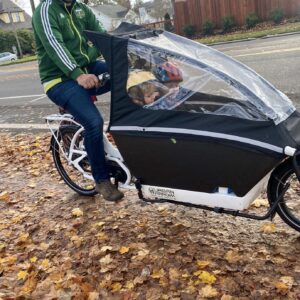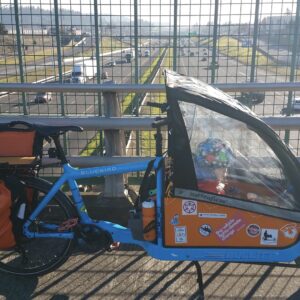
(Photo: Jonathan Maus/BikePortland)
“Our membership is focused around light vehicles.”
— Amanda Pietz, ODOT Climate Office
A State of Oregon project to study the needs and gaps of electric vehicle charging infrastructure has a gap of its own: No one on the 18-member advisory committee represents electric bicycles.
Despite thousands of e-bikes sold each year at hundreds of retail locations statewide and the skyrocketing use of e-bikes as personal vehicles by many Oregonians, the Oregon Department of Transportation has declined to add a cycling voice to the Transportation Electrification Infrastructure Needs Analysis (TEINA) project advisory group.
Advertisement
According to the project website, “Convenient, accessible charging infrastructure is a critical driver in accelerating the widespread adoption of electric vehicles (EVs) and other types of electric transportation (such as electric buses, delivery vans, freight trucks and e-bikes) and to achieve the state’s greenhouse gas emissions reduction goals.” The goal of the project is to, “Provide a near-term and long-term high-level overview of the charging infrastructure needs for other vehicle classes and use types, ranging from medium and heavy-duty trucks and buses to e-bikes and e-scooters.”
We first flagged this concern in a story about the TEINA project on December 3rd. Since then we’ve learned others have expressed frustration to ODOT about the issue but the agency has resisted requests to expand the committee.
Of the 14 advisory group members who are not government agency staff; three represent drivers and cars (AAA, General Motors, and an EV advocacy group), one is from a research firm, two are from the nonprofit sector (climate change and social justice), two are charging station product manufacturers, and six represent electric utility companies (like PGE and PacifiCorp).
Advertisement
The TEINA is being led by the ODOT Climate Office and springs from Governor Kate Brown’s executive order on climate action. That order pushes ODOT to follow Senate Bill 1044, which was passed in 2019 and set goals for the amount of registered electric vehicles and charging stations in Oregon. An implementation report for the executive order outlines ODOT’s roles and responsibilities related to the TEINA project: “Gather and analyze existing data, and describe current transportation electrification use types and vehicle classes… Compile information on factors that influence the need for charging, and the unique challenges in rural areas, urban areas, and travel corridors. Assess future potential impacts of trends and opportunities across transportation electrification use types and vehicle classes…”
Asked why no there’s no bike-specific voice on the advisory group, ODOT Climate Office Director Amanda Pietz said, “Our membership is focused on the directive of the Executive Order, which is around light vehicles.” In ODOT’s view, “electric vehicle” pertains only to electric cars — not electric bikes. This is a subjective viewpoint given that Oregon law (ORS 814.400) says, “When the term ‘vehicle’ is used the term shall be deemed to be applicable to bicycles.”
Other sources say TEINA is only about high-wattage charging infrastructure along major corridors and therefore isn’t applicable to bicycle use. That framing marginalizes e-bikes from the outset, assumes e-bike users don’t want to go long distances (they would if they could count on publicly-accessible charging stations), and creates an unfair playing field for car users.
With this driving and car-centric framing, the TEINA process shoves bikes over into the margins along with e-scooters, bike share systems (“micro-mobility”), buses, and freight trucks. At the second (of four) TEINA advisory group meetings on Tuesday, a presentation (PDF) shared nine electrification use-cases. It included things like urban and rural “light duty vehicles,” “long haul trucking”, and “micro-mobility”. The presentation also included maps and data about where EV chargers are currently located. The use of personal e-bikes was not among the use-cases and there was no mention of charging locations for e-bike use (beyond micro-mobility which is a completely separate use-case).
Pietz assured me that the TEINA effort is “very preliminary”, that there’s more work to follow and, “the interest in supporting an e-bike future is there.” Pietz added that forthcoming focus groups will include input from e-bike advocates.
Advertisement

(Source: ODOT presentation)
Without a seat at the main table there’s a real risk this report will miss a crucial element of Oregon’s electric transportation future. The saying, “What you don’t measure doesn’t count,” seems to apply here.
Phillip Ross is director of sales and marketing at B-Line Sustainable Urban Delivery, a last-mile freight and logistics company based in Portland. The company has been in business for 12 years and runs a fleet of 12 electric and pedal-assisted cargo trikes out of a central eastside hub. In 2020 the company made 16,544 deliveries from 197 vendors. Ross has also been attending monthly meetings of the nascent “E Bikes for All” group convened by Forth, an electric vehicle advocacy nonprofit. The TEINA project was discussed at their meeting Thursday morning.
Reached after the meeting, Ross said, “It disappoints me that ODOT has not offered a seat at the table for so many voices that represent the community at large when planning such consequential projects… Without a seat at the table the elected officials and policymakers that rely on ODOT’s guidance for making smart transportation policy are flying blind.”
Wake Gregg, owner of The EBike Store in north Portland, agreed. “E-bikes and cycling in general need to be represented at all critical ODOT infrastructure meetings. Why would they exclude the most efficient form of motorized transportation?”
— Jonathan Maus: (503) 706-8804, @jonathan_maus on Twitter and jonathan@bikeportland.org
— Get our headlines delivered to your inbox.
— Support this independent community media outlet with a one-time contribution or monthly subscription.






Thanks for reading.
BikePortland has served this community with independent community journalism since 2005. We rely on subscriptions from readers like you to survive. Your financial support is vital in keeping this valuable resource alive and well.
Please subscribe today to strengthen and expand our work.
This is disappointing.
Jonathan,
Good on you for holding ODOT’s proverbial feet to the fire! Seems like they need to rethink their definition of electric vehicles and make it more inclusive.
A “charging station” for an e-bike is an electric outlet, and that is not the case for a car.
Given the range of e-bikes nowadays, the lack of standardization (as opposed to car charging), electric outlets are everywhere, and long charging times, and the fact that people who want more range can just lug an extra battery, building specialized bike infrastructure for the miniscule number of people who want to go particularly long distances e-assisted and are willing to wait is a total waste.
As far as the cargo bikes go, is the idea is that riders will wait for a charge rather than swap out batteries/bikes between deliveries?
Anyone who’s really going that far and wants to go on electricity can get an electric motorcycle which is a better tool for the job, has more range, and can charge at a car station.
hey kyle I am not sure that you have owned electric bikes or cars, but the lack of a standard in quick charging for cars (3 competing standards) has been a huge problem. An e-bike charger is only just a plug if you bring your charger with you, a better e-bike charging network would like the chargers for cars not require you to bring your own charger from home. Would be great to see large government agencies be they the EU or California or whoever to require a standardized plug for charging for cars as well as ebikes, just like with cell phones these competing standards lead to a ton of waste.
Such a network would require the standardization that doesn’t exist, and there is still the basic issue that there’s no real use case for e-bikes going that far that’s not purely recreational.
In any case, building the network at this point makes no sense. There are a lot better places to invest money/energy to help cycling.
Even by your own description, the use case is someone who needs to go at least 50 miles on an especially expensive bike that requires extra maintenance, is willing to wait a long time for a charge, but is not willing to carry an extra battery on a bike that puts out way more than double what even a strong rider can.
This is not an endeavor that should be subsidized.
There is also the issue that this simply contributes to the ghettoization of bikes. Demand separated infrastructure that’s powered (why not put a roof over the top while we’re at it), and even cyclists insist they can’t ride on the roads. This will not end well.
Kyle, your viewpoint seems too narrow and your commentary seems to lack a basic understanding of e-bikes. It sounds as though you don’t own or use an e-bike, so you may not be the best person to comment on them.
I own two e-bikes and use them mainly for commuting and errands, not for recreation. So your statement “There no real use case for e-bikes that’s not recreational” is simply false. In fact, the use case is the opposite: those of us who own them use them mainly to displace automobile trips for commuting and business, while we ride our non-e-bikes for recreation. Again, if you owned and rode an e-bike you would know this – you would know that recreational riding on a e-bike isn’t that fun b/c the e-assist removes the challenge.
One reason (among many) that it’s bad to keep e-bike advocates off the TEINA group is that no one will be looking at the issue of e-bike commuting and how employers can either encourage it or essentially prohibit it by not allowing e-bike charging at the workplace. Many workplaces now have e-car charging facilities for employees, but there’s nothing analogous for e-bikes. An employer can simply say, “You can’t bring your e-bike into the building” and they have effectively banned e-bike commuting.
So there are bigger issues this group should be looking at, and they won’t in the absence of an e-bike advocate.
I don’t own one, but how far is your commute and errands that you need to recharge while out (finding an e-bike with 50 mile range isn’t hard), and why didn’t you get a model with a removable battery so you could charge it at a regular outlet which you can find everywhere?
In a best case scenario, a few charging stations will do next to nothing for providing real capacity — especially since almost no one will actually be near one of them.
I didn’t say there is no use for e-bikes that’s not recreational, I said there was no use case for going that far that’s not recreational beyond a few nut jobs who do not need to be subsidized.
Employers might not let you bring a messy bike in the building, but the overwhelming majority aren’t going to quibble about charging a battery.
Kyle, You raise good points about chargers. I don’t own an e-bike, but those I’ve known with them (mostly coworkers), have generally brought their batteries into the office and charged them at their desks. This implies that the batteries must be as easy to remove as, say, a headlight, which would further imply that they (or the chargers/cords themselves) would be subject to theft if left in an unsecured charging area outside.
Fred also raises good points about employers’ ability to restrict bike charging activities in their buildings, while at the same time providing essentially free fill-ups to their car-driving employees (talk about incentive!). This is the biggest problem with this task force, IMO. It strikes me as another manifestation of the parental attitude “authorities” often take toward those who use bikes–electric or not–for transportation. They seem only concerned with how to accommodate the “grown-ups” who use “real” vehicles. If the reasons given for lack of e-bike representation had been more along the lines of what Kyle mentions, it would at least show that ODOT had considered the existence of e-bikes and their users. As it is, the “we’re only concerned with light vehicles” reasoning shows utter disregard for anything other than four-wheel-footprint, multi-ton vehicles that do much more extensive damage than mere GHG emissions.
Regarding Kyle’s other point about “separate but equal” bike infrastructure, there is something to the symbolism of providing charging stations for one type of vehicle, while not considering another type. Providing charging stations for cars tells those car owners, and the world at large, “this is how you are supposed to do it. Thank you, Mr. E-car, for showing your concern for your fellow citizens and, yea, our very planet, by driving a gigantic, space-wasting, inefficient, pedestrian-killing toodle-box. Here’s some subsidized energy! Oh, e-bike users–yeah, uh, whatever, freeloaders.” I don’t think bicyclists of any kind can win here. There should be a choice of “safe” separated-but-also-direct bike roadways for those that simply will not ride under any other circumstances, but that should not preclude bicyclist use of main roadways. Likewise, e-bike riders should have the same access to public charging, (whatever form that may take) as EV drivers whether they decide to use it or not. Until the shift in public perception of bicyclists as either “elitist/hippie children on a lark”, or “scum-of-the-earth, musta-got-a-DUI losers” changes to “responsible folks who consume vastly fewer resources while enjoying necessary travel”, we’re stuck where we are.
As long as the focus is on how to get people to use different cars, rather than how to get people to not use cars at all (at least for rote trips, like commuting), then it seems to me we are mis-investing.
Shawn Martinez, just as a case study, recently wrote in this blog about two recent trips where he would have used recharging for his e-bike mid-trip: https://bikeportland.org/author/shawnebp
Establishing a standard before building out multiple parallel infrastructure systems seems like the right order to do it. Now would be that time (at least as opposed to the future; the past was arguably better).
I’d go for a very simple standard US-type 120v, polarized, extension cord as “the standard.” Male one end, female the other. The bike battery would provide the insulation/protection for its exposed male plug, and its own voltage wart (small and cheap). Adapters could fit non-standard models (again, small, cheap, and can stay with the bike/battery or be pocket-sized).
El Biciclero, yes, batteries are a pilferable theft target. They generally have a locking mechanism to the bike frame.
Agreed. I own an electric car (actually two of them) and bicycle a lot, so I feel that I can speak about this topic from a knowledgeable perspective.
Currently, the state of EV charging in Oregon is pretty appalling compared to the East Coast and California. Most of these faster chargers (what we call Level 3, or DC Fast Charging – 50 kw+) are either old or limited to the I-5 and I-84 corridors. They have big bulky plugs and enable long distance travel – ie vacations and intercity travel. Most of the in-city chargers are being built by private developers, such as Blink, Chargepoint and Tesla in urban locations, such as hotels and shopping centers.
The lack of intercity charging infrastructure is one of the biggest stumbling blocks of EV adoption, as Americans love to point out the lack of charging infrastructure as the reason to go buy another gas powered SUV or pickup or *cough* Subaru *cough*.
Obviously there is a need for more in-town charging locations as well – there are a real dearth of charging locations anywhere in Oregon compared to some other states. However, those can be less expensive “Level 2” chargers (up to 10 kw typically) and only cost about $1,000 worth of hardware – quite cheap compared to the Level 3 chargers. These will be more useful for residents who are unable to charge their cars at home, for whatever reason (no driveway, apartment living, etc).
As e-bikes aren’t typically used for inter-city travel, they have different needs. However, ALL housing in the US requires basic electrical service with multiple 120 volt outlets, which is exactly how you charge an e-bike. So… ideas? I would support an urban EV/E-bike charging task force to look at how to provide urban (only) infrastructure for EVs and e-bikes to be charged at home, the workplace, and retail locations. Then have the other task force focus on inter-city locations, like rest stops and restaurant pods like you find in Norway:
https://www.weforum.org/agenda/2018/08/the-oslo-model-how-to-prepare-your-city-for-electric-vehicles/
Oh look, Bosch has some e-bike charging equipment already designed:
https://www.bosch-ebike.com/en/service/powerstations/
“Just carry an extra battery” … do you realize that the battery is the most expensive part of a lot of ebikes? Extra batteries cost hundreds of dollars.
…if not $900. Also, batteries can be bulky and rather heavy.
Meanwhile “chargers”(the electrical bit that goes between the bike battery and the wall outlet) are quite a bit lighter.
Here is the website for the electric bikes for all group, including all of our meeting notes. Pretty great group, if you are interested in joining in send me an email. https://www.electricbikesforall.org (jonathan feel free to insert into article)
Oh great. Another round of Park and Rides Planned at all the new charging stations. How are people going to get to the charging station? Sourrounded by seas of parking. This is another disaster in the making, like the SW corridor Max line. Our e bike manufacturers, homegrown Oregonians not even included at the table. 14 people committe at ODOT will be as effective as the last 5 RQ committees.
Especially as they’ll agree to do whatever California is doing.
Sadly, this is not surprising. (It being repeated throughout the states.)